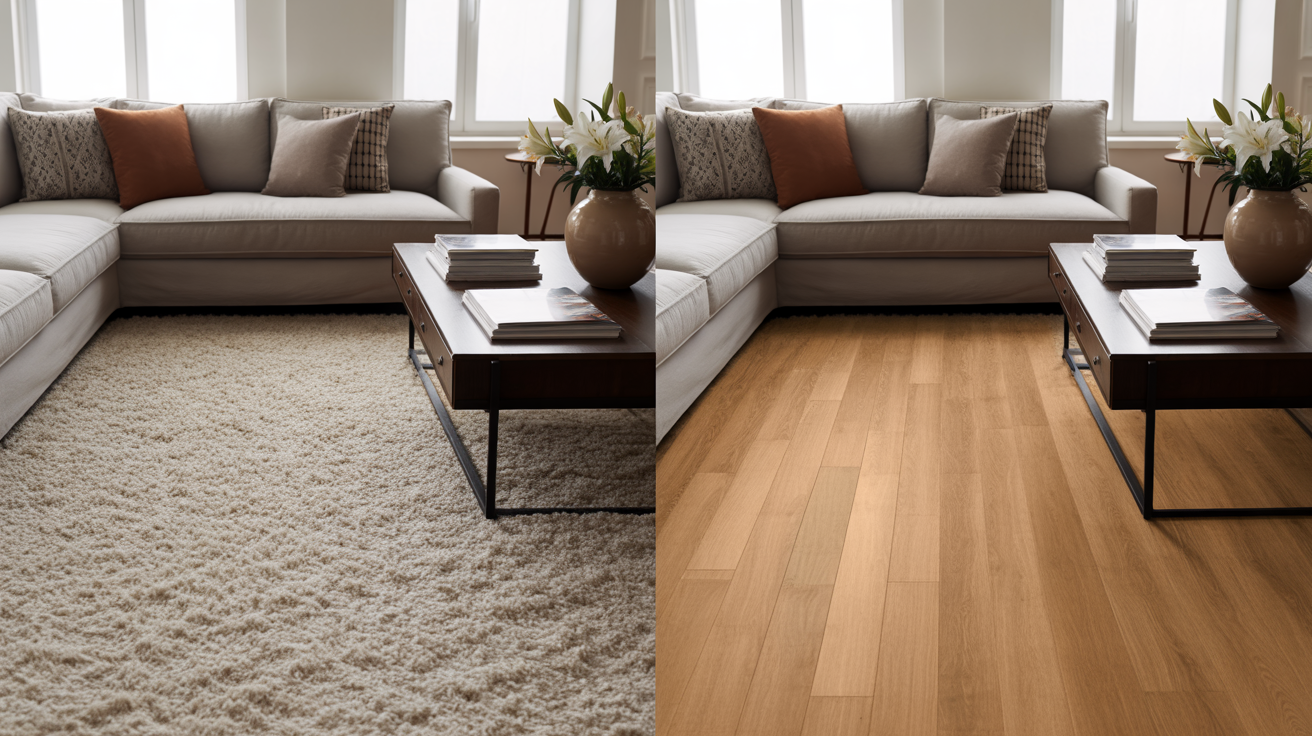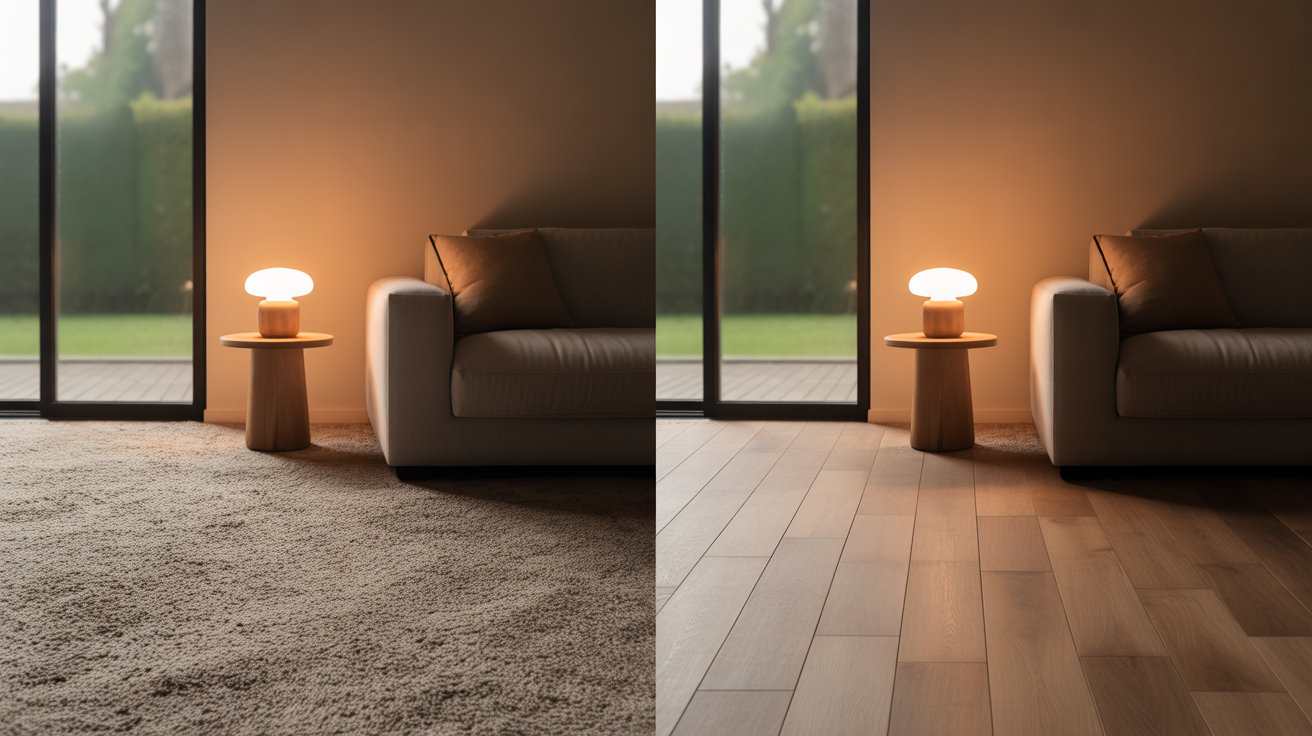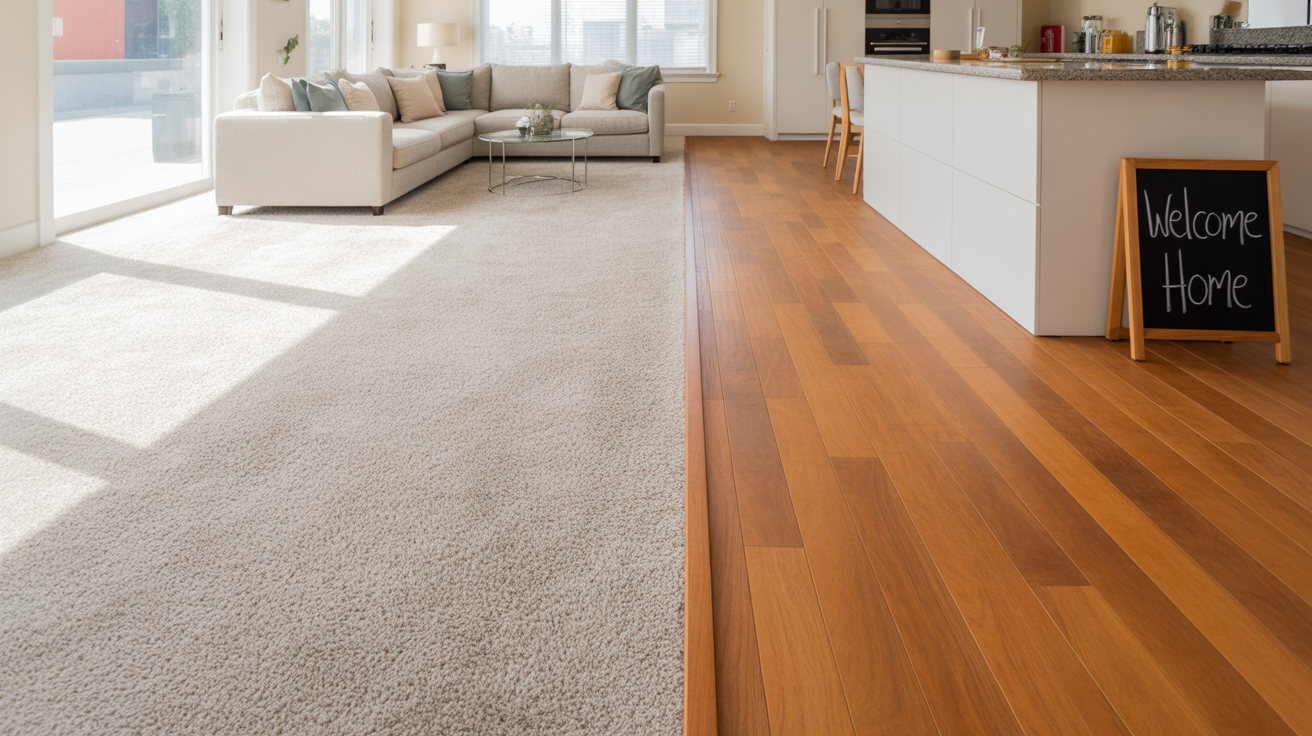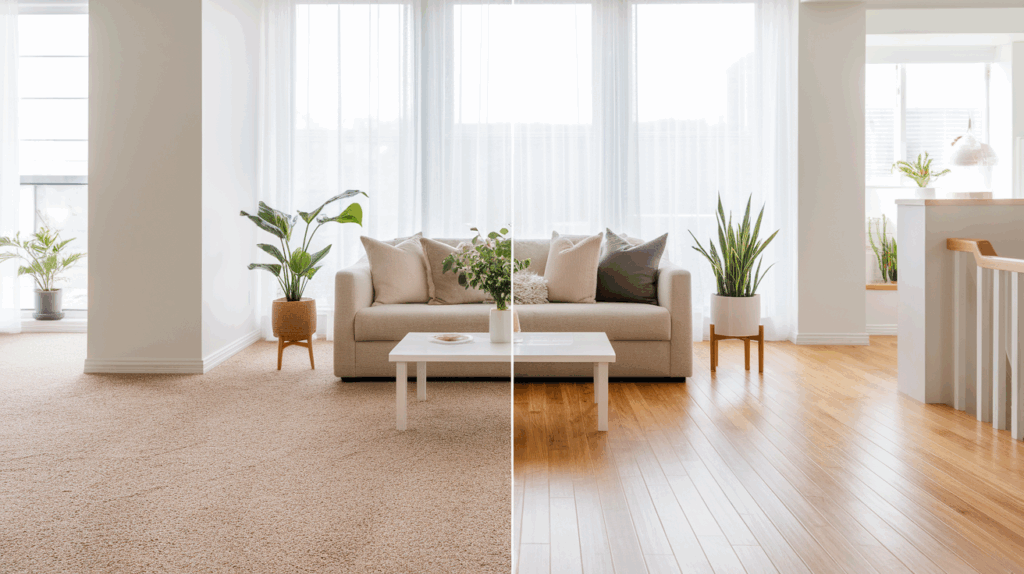Choosing the right flooring for your home isn’t just about looks or cost—it can also affect your health.
One of the biggest questions people ask is: What is healthier, carpet or hardwood floors? The answer depends on a few things, like allergies, how easy it is to clean, and what kind of air you breathe indoors.
Both options have pros and cons. Carpets feel soft and cozy, but they can trap dust and allergens. Hardwood floors are easy to wipe clean, but they might feel cold or hard underfoot.
In this blog, I’ll compare carpet and hardwood floors in a simple, straightforward way. I’ll discuss how each one affects air quality, allergies, comfort, and even the environment.
My goal is to help you (just like I helped myself) decide what’s best for your family’s health and your home.
I’ve looked into both options carefully, and I’m excited to share what I’ve learned with you.
Understanding Carpet and Hardwood Floors

Before we talk about which is healthier, let’s get to know each flooring type a little better.
Carpet is soft and made from woven fabric or fibers. It feels warm under your feet and is great for cozy rooms like bedrooms and living rooms.
Carpet comes in many colors and styles, and it can make a room feel quiet and comfortable. But it can also hold onto dust, dirt, and pet hair.
Hardwood floors are made from real wood like oak, maple, or cherry. They’re smooth and strong, and they can last a long time if you take care of them.
Hardwood is easy to clean, and it gives your home a clean, classic look. It doesn’t trap as much dirt, but it can get scratched or damaged by water.
Carpet vs Hardwood Floors: Which Is Better?
Let me walk you through carpet and hardwood floors in terms of health, comfort, and everyday use.
I’ll examine the key areas that really influenced my decision, such as allergies, air quality, moisture, comfort, and cleaning.
These points mattered a lot to me when I was deciding what would be healthier for my home and family, and I think they’ll help you, too.
Impact on Allergies and Asthma
Carpet:
- Traps dust and allergens. Carpets hold onto particles like dust mites, pollen, and pet hair. Even if you vacuum often, it’s hard to get every bit out.
- Not ideal for allergy sufferers. People with asthma or allergies may find that carpet makes their symptoms worse.
- Hard to clean deeply. Dust and dirt settle into the fibers, and even strong vacuums can miss some of it.
Hardwood Floors:
- Better for allergies. Hardwood doesn’t trap dust or pet dander, so it’s easier to keep the air clean.
- Easy to wipe down. You can sweep or mop it with a damp cloth, and the surface stays cleaner.
- Great for homes with pets. If your pets shed a lot, hardwood lets you clean up quickly.
If someone in your house has asthma, seasonal allergies, or dust sensitivity, hardwood floors are usually the healthier choice. They don’t hold onto allergens the way carpet does.
Indoor Air Quality: Carpet vs Hardwood Floors
Carpet:
- It can give off chemical smells. Some carpets release VOCs (volatile organic compounds), especially when new. These can cause headaches or eye irritation.
- Holds onto odors. Over time, carpet can absorb smells from pets, food, or smoke.
- Needs deep cleaning. To keep the air fresh, carpets require more regular shampooing or steam cleaning.
Hardwood Floors:
- Low VOC options available. Most hardwood floors today are sealed with low-VOC finishes, making them safer for indoor air.
- Smells don’t stick around. Any spills or accidents can be cleaned up quickly before they start to smell.
- Helps with fresh air. Because dirt doesn’t get trapped, air stays cleaner with less effort.
If fresh air is a top concern for your family, hardwood usually helps keep your home smelling clean and reduces the number of chemicals in the air.
Moisture and Mold
Carpet:
- Soaks up moisture. Whether it’s a drink spill, a leak, or wet shoes, carpet fibers absorb water fast.
- Mold can grow underneath. If the carpet stays wet too long, mold or mildew can start to grow in the padding or subfloor.
- It can be expensive to fix. Moldy carpet often needs to be pulled up and replaced.
Hardwood Floors:
- Water doesn’t soak in right away. Hardwood gives you time to clean up spills before they cause damage.
- Still not waterproof. If left wet, hardwood can warp or swell, especially with big spills or leaks.
- Easier to spot problems. Since moisture sits on the surface, you can catch it early and clean it up fast.
Takeaway: Neither floor type is perfect when it comes to water, but carpet is more likely to hide moisture and grow mold. Hardwood gives you a chance to catch issues before they turn into bigger problems.
Comfort and Insulation
Carpet:
- Feels soft and warm. It’s comfortable to walk, sit, or lay on—great for kids or pets.
- Reduces noise. Carpet soaks up sound, so it’s quieter in rooms with lots of activity.
- Keeps rooms warmer. In colder months, carpet adds a layer of insulation and helps keep heat inside.
Hardwood Floors:
- Firm underfoot. Hardwood doesn’t have any give, so it may not be ideal for people with sore joints or knees.
- Can echo noise. Especially in large rooms or hallways, footsteps and voices bounce around more.
- Feels cold. It doesn’t hold warmth like carpet, but area rugs can help with this.
If comfort and warmth are important in a space—like a bedroom or playroom—carpet feels cozier. But for a clean and open look, hardwood still works and can be softened with rugs.
Maintenance and Cleaning
Carpet:
- Takes more work. You need to vacuum regularly and deep-clean often to keep it fresh.
- Stains are tough. If something spills, it can soak in and be hard to remove.
- Can hold on to bacteria. Germs, food bits, and allergens can stay hidden in the fibers.
Hardwood Floors:
- Easy daily care. Just a broom, mop, or vacuum is enough to keep it clean.
- Stains stay on the surface. Most spills wipe away with a simple cloth.
- More hygienic. No fibers for dirt or bacteria to hide in.
Hardwood is an easier floor to clean and keep healthy. Carpet can stay looking nice, but it takes a lot more effort to keep it that way.
Understanding the Style and Design of Carpet vs Hardwood Floors

When it comes to the way my home looks and feels, I’ve learned that flooring makes a big difference.
Both carpet and hardwood floors offer their unique style. I really like the warm, soft look of carpet in cozy spaces, but I also appreciate the clean, classic feel that hardwood brings to a room.
Depending on the vibe I’m going for, I’ve found that each one has something special to offer.
| Feature | Carpet | Hardwood Floors |
|---|---|---|
| Look and Appearance | Soft, cozy, often textured | Smooth, sleek, natural wood patterns |
| Style Options | Many colors, patterns, and textures | Different wood types, stains, and finishes |
| Room Feel | Warm and casual | Clean, classy, and timeless |
| Home Style Match | Great for traditional and casual homes | Fits modern, classic, or farmhouse styles |
| Decor Flexibility | Can be bold or neutral | Neutral tones go with most decor |
Choosing between carpet and hardwood often comes down to personal taste. If you want a cozy, warm feel with lots of color choices, carpet might be a better fit.
But if you like a clean, classic look that works in almost any room, hardwood is a strong choice.
Think about your home’s design style and how you want each room to feel—your floor can set the tone.
Pros and Cons of Carpet and Hardwood Floors
When trying to decide what’s healthier, carpet or hardwood floors, it helps to look at the pros and cons of each.
Both flooring types have good and bad sides, so it really depends on what matters most to you and your home.
Carpet
Pros:
- Feels soft and warm under your feet
- Helps keep rooms quiet by reducing noise
- Adds comfort in bedrooms, playrooms, or cold spaces
- Comes in many colors and styles to match your decor
Cons:
- Traps dust, allergens, and pet hair
- Harder to clean deep down
- It can grow mold if it gets wet
- May release chemicals (VOCs) in some materials
Hardwood Floors
Pros:
- Easy to sweep and mop
- Does not hold allergens or dust
- Looks clean and stylish in any room
- Lasts a long time with proper care
Cons:
- Feels hard and cold, especially in winter
- Can get scratched or damaged by water
- Makes more noise when walking
- Usually more expensive to install
No floor is perfect for everyone. The carpet feels cozy and warm, but it can hide dust and dirt. Hardwood is cleaner and better for allergies, but it can be less comfortable.
Think about your family’s needs, how much cleaning you want to do, and your home’s layout. That way, you can pick the floor that works best for your health and lifestyle.
Can You Use Carpet and Hardwood Floors in The Same House?

Yes, you definitely can use both carpet and hardwood floors in the same house—and many people do! In fact, mixing flooring types is a smart way to match each room to its purpose and style.
For example, hardwood floors work great in places like the living room, dining room, and hallway.
They look clean and polished, and they’re easy to keep tidy. These areas usually get a lot of foot traffic, so hardwood is a strong choice that can handle daily wear.
Carpet, on the other hand, is a cozy option for bedrooms, playrooms, or basements. It feels warm and soft under your feet, which is perfect for relaxing or spending time with family.
You can even add area rugs on top of hardwood floors to bring in some softness without fully switching to carpet.
It’s all about choosing what feels right for each space. So go ahead and mix it up! Using both carpet and hardwood gives you comfort where you need it and style where you want it.
Conclusion
When it comes to choosing what is healthier, carpet or hardwood floors, there’s no one-size-fits-all answer.
Each option has its pros and cons. The carpet feels soft and warm, making it great for comfort, but it can trap dust and allergens.
Hardwood floors are easier to clean and better for allergies, but they may feel cold or hard underfoot.
Think about what matters most to you. Do you need extra warmth in the bedrooms? The carpet might be best there.
Want clean air and easy cleaning in the living room? Hardwood is a smart choice.
You can even use both in your home to get the benefits of each. In the end, the healthiest choice is the one that fits your family’s needs, lifestyle, and comfort.
Take your time, weigh the pros and cons, and choose what makes your home feel just right.

